The low cost and utter simplicity of small portable toilets make you think twice about fully plumbed marine heads. While installed heads can get complex with hoses, valves, and through-holes, porta potties are basic fill-and-dump systems-two tanks and a pump, thats it.
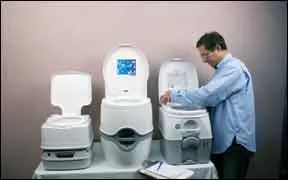
A few steps above the old cedar bucket, portable toilets are essentially glorified waste containers, but a good one offers more comfort than a bucket, wont leak, and can be emptied and cleaned with limited hassle. Plus, you can use them on all U.S. waters without the risk of violating marine sanitation regulations.
What We Tested
We last reviewed portable toilets in the October 2005 issue, and Thetford Marines products were testers top picks. This time around, we tested three portable toilets made by Thetford-the Porta Potti 260, the Porta Potti 550P, and the Porta Potti Curve-and two West Marine-brand port potties manufactured by Dometic/SeaLand, the Runabout 962 and the Cruiser 976. Dometic and Thetford are both global companies leading the marine-sanitation industry.
The test toilets were all constructed of polyethylene plastic and have either a piston, electric, or bellows-style pump. The bellows pumps use a bellows device to move the water, and the piston pump employs a high-pressure seal and a piston. In our experience, the plastic bellows pumps arent as durable as the piston pumps. They break more readily and tend to leak with extended use.
All of the test potties would fit on board a pocket-cruiser or larger boat. The Thetford 260 and West Marine Runabout also would fit onboard most daysail boats with cuddy cabins.
How We Tested
We based testing on the real-world situations in which most people use portable marine toilets (day sailing, weekend trips, cleaning them, transporting them, etc). Testers evaluated the dimensions of the toilets, toilet bowls, and toilet seats; the freshwater and wastewater tank capacities; toilet and tank weights (empty and with full tanks); ease of use; and construction quality. Then, we put the porta potties through their paces: Testers filled the freshwater tanks, looked for spills, and pumped the water into the bowls. We tested emptying the bowl into the holding the tank, and rated the levers and latches used to connect the freshwater and holding tanks. We also carried and emptied the wastewater tanks, with a close look at procedure, ease of emptying, and tendency to spill.
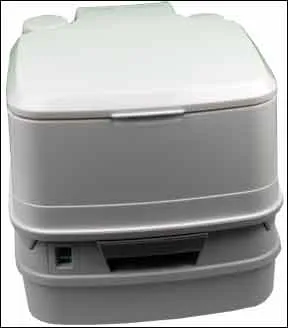
Testers also rated the potties for comfort-and while comfort is relative, these things are not thrones. All the test toilets stand less than 24 inches off the ground and have an average seat diameter of less than one foot. Comparatively, a typical house toilet stands about 28 to 32 inches tall and has a seat that’s 14 to 17 inches wide.
Testers measured how much water per pump each toilet used, and gauged that both West Marine test toilets required three pumps per flush and each Thetford toilet required six pumps. With that, we calculated the number of flushes per tank based on freshwater tank capacity.
Testers also looked at the tanks waste level indicators, fill and empty caps, locking mechanisms, and price. The Thetford toilets come with three-year warranties; the West Marine heads have one-year warranties.
Size and MSDs
One thing testers noticed right out of the gate: When it comes to portable thrones, size does matter. Users will have to balance the size and capacity of the toilets with how often they want to empty and clean the wastewater tank. A bigger tank can go longer without being emptied, but it will be heavier to haul down the dock and dump when its full.
The porta potties we tested are heavy when full (see Value Guide), and youre not going to want to cradle them against your torso for support while transporting them for obvious reasons. Carrying them away from the body with arms extended can be hard on the arms and the back, especially when dumping larger-capacity wastewater tanks.
For a general reference, remember that a gallon of liquid weighs about 8.35 pounds. So a full 2.6-gallon wastewater tank weighs nearly 22 pounds, and if you have a porta potty with a 5.5-gallon wastewater tank, youre looking at over 45 pounds of waste. Dock dolly anyone?
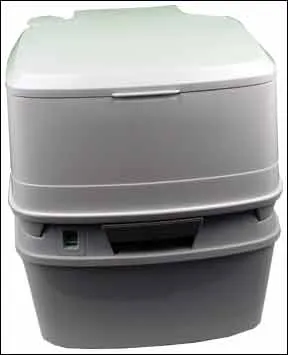
A word about Marine Sanitation Devices (MSDs): Regulations covering the certification and use of MSDs are issued by the U.S. Coast Guard. In general, regulated sanitation systems comprise an installed head, a waste-treating device, and/or a holding tank. Unless plumbed to a permanent, fixed system, portable toilets are not considered to be MSDs, so they are not regulated and are legal to use on all U.S. waters. (For more on MSD regulation, check out this article online.)
Thetford 260
The Thetford Porta Potti 260 was the simplest toilet in our test group and for that reason, a favorite of testers. With few bells and whistles, there are fewer things that can break.
The Porta Potti 260, the smallest toilet in the test group, stands just over a foot off the ground and is just more than a foot wide. The freshwater and wastewater tanks each hold 2.6 gallons. The lid and toilet seat can be removed for easier cleaning. The 260s seat and toilet bowl were the smallest of the Thetford test toilets, but they were still slightly larger than those of the West Marine toilets.
As with all of the test toilets, the 260s freshwater tank is filled through an opening on its top. The model we tested had a piston pump, but the 260 also is available with a bellows-type pump, and there are two MSD models.
The 260 is comfortable enough to sit on, it pumps easily, and the waste is easy to empty into the holding tank, simply by pulling a sturdy lever on the toilets front. Testers also noted that the tanks are easy to separate-simply slide a lever in the back of the toilet and release the latch-reset, and connect back together.
The six-inch spout on top of the wastewater tank easily rotates 280 degrees, making dumping easier. A valve releases any pressure built up in the waste tank and helps prevent splashing.
The wastewater tank does not have access for cleaning other than the release opening and the spout opening, but this was true for all models in our test. The holding tank level indicator is a simple green square on the front of the holding tank that eases toward red as the tank fills. When full, the wastewater tank weighs approximately 22 pounds. It has an ergonomic carrying handle, but there is no handle on the freshwater tank.
Our testers found no leaks during normal use, lifting, transporting, and dumping, but if the toilet is tilted (like when the boat is excessively heeled or pounding into waves), the freshwater tank will leak at the cap if it is full.
The 260 sells for $76 online. Bottom line: Simple and easy to use, the 260 gets the Budget Buy pick and our Recommendation for a basic, small portable toilet.
Thetford 550P
Although its more than 4 inches taller than the 260 with a slightly bigger seat and a deeper bowl, the Thetford Porta Potti 550 doesn’t seem to offer many other advantages over the 260, in our opinion. Construction, gauges, and quality are the same, as are the pumps and the release levers.
Our Thetford 550 test unit was an MSD model intended for permanent plumbing, so it did not have a spout for dumping the waste tank. The MSD option would be for permanent installation only. We did not test this function.
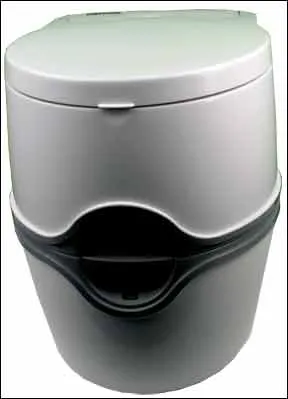
Testers could not get the lid of the 550s freshwater tank to close. This allowed water to leak out of our test unit, when it was moved, essentially rendering the toilet useless on a moving boat; however, we suspect the freshwater tank cap on the non-MSD models is designed differently.
Both the 260 and 550 allow 2 ounces of fresh water from one pump of the piston. With the 550s 4-gallon freshwater tank, that allows an average of 43 flushes before you need to refill the freshwater tank. The wastewater tank is 5.5 gallons, and the tank contents weigh approximately 45 pounds when full. Add to that the toilets 10.55 pounds, and you may need a dock cart, or an extra hand, to haul the toilet for dumping. Marina managers might also have a problem with this much waste being poured into a marina toilet.
Note that before you put anything into the 550s bowl, the two tanks have to be securely fastened or else the waste and fresh water will spill onto the holding tank. The good news is that, like us, youll only make this mistake once. The holding tank has a sealed valve to keep odors trapped.
The Thetford 550 costs $140 online. Our test model included a tie-down kit.
Bottom line: Other than its larger size and the optional outlets for permanent installation, the 550 doesn’t offer many advantages over the 260. A bigger toilet may be more comfortable and home-like, but it tends to take the portable out of porta potty, when it comes to dumping it.
Thetford Curve
A portable toilet with electric flush? Thats the case with Thetfords Porta Potti Curve, which adds a little glamour to the portable toilet concept with battery-powered flushing. We were initially skeptical of the seemingly unnecessary feature, but once the six AA batteries were installed and testers tried it, we were impressed.
The Curves construction and design are similar to Thetfords 260 and 550 models, with the exception of a rounded overall shape that mirrors the curved toilet seat. Its seat and toilet bowl dimensions are the same as 550s, making the two the largest in the test field. The Curve also has a freshwater-tank level indicator and a toilet-paper holder on its side. The lever that empties the bowl into the holding tank pulls out from the right side of toilet, so the toilet will require a little more lateral space for installation.
The cap on the Curves freshwater tank seals securely, and testers would have preferred that the same design were used on the 250 and 560, both of which have comparatively poor seals here. Also, unlike its siblings, the Curve has excellent carrying handles molded into both the freshwater and waste tanks, for easier toting on and off the boat.
Pressing the battery-powered pump button releases a controlled pulse of water. The pump continues to pulse water out from the tank with continued pressure (as opposed to a flow of water). Testers noticed that using the battery-powered pump usually resulted in more water being used per flush than when testers flushed those with manual pumps. The Curve doesn’t require more water than the other Thetford toilets to flush the bowl, but the convenience of the electric pump made it easy to forget to be frugal with the water usage, resulting in the freshwater tank draining more quickly.
A hard, plastic cover offers some protection against accidentally engaging the battery-powered pump button. But if theres enough weight on the cover-like a toolbox-the pump will turn on and stay on, even after the tank is empty.
According to Thetford, a fresh set of batteries should last a season in the Curve, and the company recommends installing a new set of batteries at the beginning of each sailing season.
Testers like the ease of use and design of the Thetford Marine Porta Potti Curve-it is higher off the ground and slightly more comfortable than the 550 and 260, and the battery-powered pump is a bonus-but for portable toilets, we prefer smaller wastewater tanks over the Curves 5.5-gallon tank, which tops 45 pounds when full. The Curve does not have a manual backup to the electric pump, but users can always just add water to the bowl and use the slide lever to flush it should the batteries die.
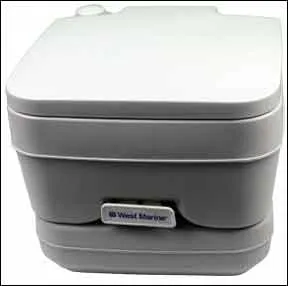
The Thetford Curve retails for $165 online, making it the most expensive in the test field.
Bottom line: Testers liked all the bells and whistles, even if they arent necessary. We Recommend the Curve for those looking for a bigger throne and who arent deterred by emptying the larger waste tank. Just be sure to keep plenty of extra batteries on hand.
West Marine Runabout
The Runabout, with a 2.6-gallon freshwater tank and a 2.5-gallon detachable holding tank, was the smallest of the two West Marine toilets we tested. Standing a foot off the ground, the sturdy Runabout uses a bellows pump and features a molded carrying handle in each tank.
Like the other test toilets, the Runabouts freshwater fill is on its top. Testers noted that when the toilet is on a heel or is rocked from side to side, fresh water leaks from the tank.
Testers found that both West Marine models pumped 4 ounces of water per pump, double the amount of the Thetford toilets. This helps rinse solids more completely from the bowl, but means fewer flushes per fill-up.
The latches connecting the Runabouts freshwater tank to the holding tank contain metal parts-this is never optimal in the marine environment. Wed prefer all-plastic latches.
The process of disconnecting the toilet before dumping was not as easy with the Runabout as other test toilets because both hands are required to hold the tank, leaving none free to clear the hanging latches. The lever that empties the bowl contents into the holding tank was also difficult to open and close. If not completely clear, waste will sit on the lid or spill down its side, testers noted.
The opening to empty the holding tank is wide and accessible, but theres no spout extending away from the tank.The opening is located on the tank side, so be sure to securely close the lid after each emptying.
During testing, water left in the Runabout bowl leaked through the drain and settled on top of the holding tank. Although its rare that waste would be left in the bowl, rather than being flushed, wed prefer to have a seal here to keep this from happening.
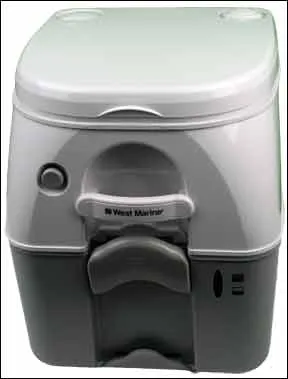
The Runabout costs $100 at West Marine.
Bottom line: The Runabout is pretty low to the ground, so users might want to set it on a platform. Average performance and a few design shortcomings kept the Runabout out of the winners circle.
West Marine Cruiser
The West Marine Cruiser is higher off the ground than the Runabout, but the body is the same sturdy construction. The Cruisers freshwater-tank cap, which was the only one in the test group with a gasket, locked down nicely and did not leak. The Cruiser has the preferred drain spout connected to the top of the waste tank, but testers still found it a good idea to empty the 5-gallon holding tank before it reached its capacity, as its too heavy once full.
The Cruisers single-mold freshwater and waste tanks are easy to connect and disconnect, testers noted, and both feature an ergonomic molded carrying handle.
The lever to empty bowl contents into the holding tank is easy to grasp and use. It and the tank latches are better designed than the Runabout. Testers werent impressed with its tank-level indicator, which would be hard to read while standing. The Cruisers seat is just slightly more narrow than the Curves, but its toilet bowl is only about 6 inches deep, a few inches shallower than the Curves and 550s bowls. The Cruiser retails for $150.
Bottom line: The West Marine Cruiser is well-made and easy to use. It gets our Recommendation for those seeking a larger capacity toilet who don’t want to
fuss with batteries.
CONCLUSION
After all the pumping and dumping was said and done, testers pick for a simple, easily portable potty was the Thetford Marine 260 Porta Potti. It is well-made, easy to use, and truly portable, even when full. It gets our Budget Buy pick, and we recommend it for small boats or for anyone looking for a no-fuss porta potty.
Testers couldnt help but like the battery-powered flush on the Thetford Curve, and they also appreciated the thought-out design of the West Marine Cruiser.
Both get our Recommendation for those seeking a little luxury in their porta-potty experience, and who have the space for a larger toilet and the muscle to haul the larger-capacity tanks. Their prices arent drastically different, so the decision would boil down to whether you have faith in electric pumps and are willing to keep feeding the Curve AA batteries. If you plan to use the toilet on a regular basis, the Cruiser or Thetford 260 would be our top picks.



































I do not know whether it’s just me or if perhaps everybody else experiencing issues with your blog. It looks like some of the text on your content are running off the screen. Can somebody else please provide feedback and let me know if this is happening to them too? This might be a problem with my browser because I’ve had this happen previously. Thanks